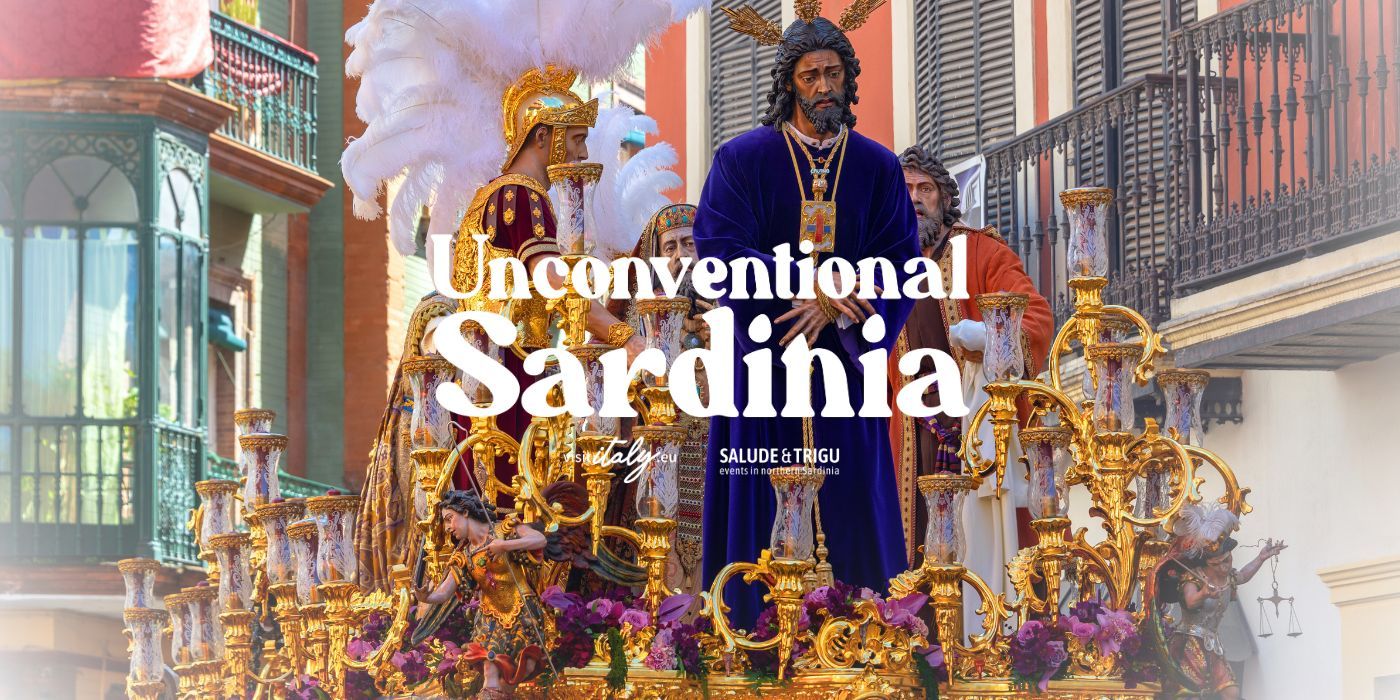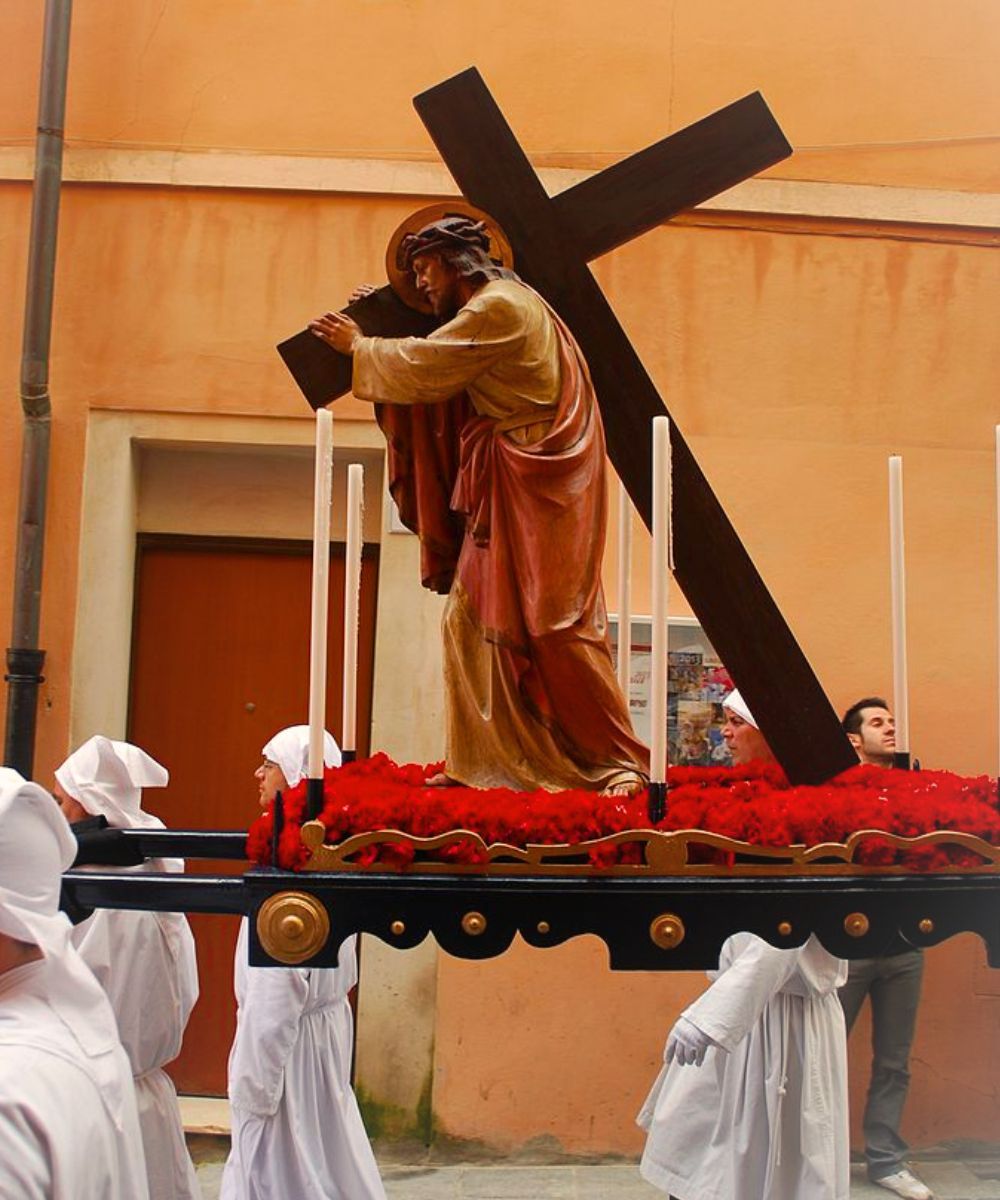When the weather is good and with the progressive lengthening of the days, inevitably the desire to travel returns for discovering new fantastic experiences, fascinating traditions and places full of emotions. And what better occasion than the Easter holidays to experience a new adventure?
Warmly celebrated with rituals and customs of great historical and spiritual relevance, Easter is the most important and heartfelt religious holiday in Sardinia, a crucial moment to cultivate the cultural identity of the territory and its people, an integral part of of the background of Sardinian cultural traditions that skillfully combines the sacred with local folk traditions.
If you’re planning to spend the next Easter holidays in Sardinia, there are extraordinary events, experiences and destinations that you absolutely can’t miss on this exciting journey through faith, beauty, traditions and food delicacies. Let's check them out!

Easter Holidays in Sardinia: how it’s celebrated and the local folk rites
Enjoying Easter in Sardinia (Sa Pasca Manna) is an experience that goes beyond the mere religious festivity, it is an opportunity for the traveler to lose themselves - only metaphorically! - in a mosaic of centuries-old traditions, evocative rites, unique emotions and authentic flavors, for a truly special holiday. Thus, in the heart of its spring, the island transforms into a stage of fascinating processions, chants and popular customs, in an atmosphere of deep and intimate spirituality.
From north to south of the region, whether in the major cities or the smaller villages, Holy Week in Sardinia is marked by events and experiences that turn on all the passion of the local culture in moments that mix together faith, beauty and great pathos. It is impossible not to mention the rite of S'Iscravamentu, celebrated in many Sardinian locations on Good Friday to commemorate the deposition of Christ from the Cross, or rather S'Incontru, which on the morning of Easter Sunday stages the emotional and joyful encounter between the risen Jesus and Holy Mary, a symbol of renewed prosperity and hope.
Of course, also unmissable are the processions of Mysteries accompanied by devotees belonging to the brotherhoods spread throughout the territory, celebrations that emphasize not only faith, but also the great creative and artistic flair of local communities, expressed by wonderful handcrafted sacred simulacra, floral compositions and spiritual chants in the Sardinian language.
Gastronomy also certainly plays a fundamental role in Easter celebrations in Sardinia. Among the most popular delicacies, Su Coccoi cun s'ou stands out, a typical semolina bread of the island characterized by a particular thorny shape (perhaps related to the crown of Christ) with an egg in the middle, a symbol of rebirth and new beginnings.
Anyway, there are many local rituals and traditions to discover while traveling during the Easter holidays in Sardinia. Following, here are 5 exciting experiences to join in the Holy Week and a few advice on the best destinations to visit!
5. The rites of Lunissanti, Prucissiuni and Ilcravamentu
The celebrations for Sa Pasca Manna are among the most anticipated and heartfelt events in Sardinia, a time of year that solemnly celebrates, in a way, also the arrival of a beautiful season and months full of vitality for the whole island. One of the most interesting destinations for Easter holidays in Sardinia is certainly Castelsardo, a splendid seaside town in the north and protagonist of the vast cultural program Salude & Trigu, which boasts a rich tradition about the Holy Week.
Among the most exciting rituals for Easter in Castelsardo there’s the solemn procession of Lunissanti, on Holy Monday, a real pilgrimage on foot that actively involves the devotees. This long day of faith begins with the celebration of the mass at dawn, propitiatory for the entire Holy Week, continuing until late evening with the long march of believers reaching the enchanting Abbey Nostra Signora di Tergu.
Worthy of mention are also the traditional Prucissiuni on Holy Thursday, a rite of great pathos focused on the meeting between the wooden simulacra of Holy Mary and Christ agonizing over his suffering, and Ilcravamentu on Good Friday, a representation of the deposition of Jesus from the cross. Not to be missed, of course, the evocative Easter mass with the celebration of S’Incontru of the simulacra of the Risen Christ with the Virgin, an experience made even more intense by the impressive sea view given by this location.
4. The Cerques and the Desclavament, the magic of Setmana Santa
Many typical Sardinian customs related to the Easter holidays boast hundreds of years of history, the result of the influence of the Spanish domination that for centuries has mixed with the local folk tradition, defining in a really unique way the cultural identity of the region. An important example is the Setmana Santa celebrated in the picturesque Alghero, the most Spanish city in Sardinia - perhaps all over Italy!
The two most iconic and exciting moments of the Easter celebrations in Alghero, colorful, passionate and full of sensations, are certainly the Cerques and the Desclavament, ancient traditions born in the Middle Ages in Spain and inherited from the folk culture of the Barceloneta. The first, also called cerche in Italian (searches), are the main event of Holy Thursday and represent the search for the tomb of Jesus by the Virgin Mary, while the second is comparable to the rite of Ilcravamentu, therefore the deposition of the simulacrum of Christ from the cross on Good Friday, but is celebrated in a solemn way at the town’s Cathedral as a real funeral ritual.
However, negative emotions soon leave to make room again for joy and renewed serenity on Easter Sunday, with the celebration of the traditional S’Incontru at the iconic Bastions of the town, a rite spread everywhere in Sardinia also originating from the Hispanic culture.
3. The Sos Sepurcros for an Easter of lights, flowers and Gosos
While in some places across Sardinia Holy Thursday is dedicated to particular processions or to the Spanish ritual of the searches, in others this important day within the Holy Week is instead focused more on the artistic aspect and the sense of community. Places like Orosei for example, a town within Baronie on the eastern coast of the island, where the top moment of the Easter holidays is represented by the celebration of Sos Sepurcros, or the visit to the tombs set up in the local churches.
Taking part in this is a special experience, where the purity of the sacred is embellished by the beauty of the creativity of devotees, decorating the crucifixes with a multitude of lit candles and refined floral decorations to make an even more mystical atmosphere.
Particular important for this magical occasion are Gosos, that are liturgical and devotional chants performed exclusively in the Sardinian language, yet originating from the Hispanic Easter tradition as well, sung by devotees of the brotherhoods during the long evening of visits to the tombs in commemoration of Jesus and his sacrifice.
2. The Mass in Coena Domini and the procession of Sas Chilcas
Similar to the searches and the rite of Sos Sepurcros, another emotional moment of Holy Thursday that’s particularly heartfelt on the Easter holidays in Sardinia is the procession of Sas Chilcas, a particular Via Crucis in which many devotees and members of the brotherhoods actively participate.
Typical especially of some villages in western Sardinia, such as Cuglieri and Santu Lussurgiu in the province of Oristano, the custom of Sas Chilcas (indeed, searches) represents the symbolic wandering of the Virgin Mary, accompanied by the devotees, in search of her son dying following his painful torture. The simulacrum of Mary is therefore carried in procession through the main streets of the villages, stopping in all the churches where the holy tombs have been set up.
This peculiar procession is held annually on Holy Thursday, after the solemn celebration of the mass in Coena Domini in commemoration of the Last Supper, one of the crucial moments for what concerns the Christian culture and, in particular, the Easter traditions.
1. The procession of Mysteries and the fascination of Baballottis
Last but not least, of course, the evocative and surreal processions of Mysteries, known in Sardinia as Sos Misterios, celebrations that are also quite popular in other regions of southern and central Italy that over the centuries have come in touch with the Spanish cultural influence.
This Easter tradition is among the most heartfelt and important, especially in the town of Iglesias, a place where every year Holy Tuesday becomes an extremely fascinating opportunity to join a truly unique experience. The great protagonists of the procession of Mysteries in Iglesias, but even in other important moments within the Holy Week, are in fact the so called Baballottis, ghostly and disturbing figures dressed in penitent clothes, completely white and with their faces covered by hoods (or Sa Visiera), who lead the march through the streets of the town holding long candles like torches and carrying on their shoulders the beautiful sacred wooden simulacra - in order, the Prayer, the Capture, the Flagellation, the Ecce Homo, the Ascent to Calvary, the Crucifixion and the Sorrowful Virgin.
The procession of Mysteries represents one of the most interesting and exciting moments to experience during the Easter holidays in Sardinia, a ritual where faith, ancient folk traditions and the amazing cultural mix of the island come together in an extraordinary storytelling that goes beyond religion, but instead highlighting the emphasis on the beauty of cultivating the identity of one's own history and roots. An absolutely fundamental element for Sardinian people, which this springtime you can discover and experience first-hand too by visiting the most magical island in the Mediterranean at Easter!
About the author
Written on 27/03/2025




Massimiliano Antonio Primi
Discover 5 experiences for Easter holidays in Sardinia, an exciting journey that embraces faith, beauty, traditions and food delicacies.